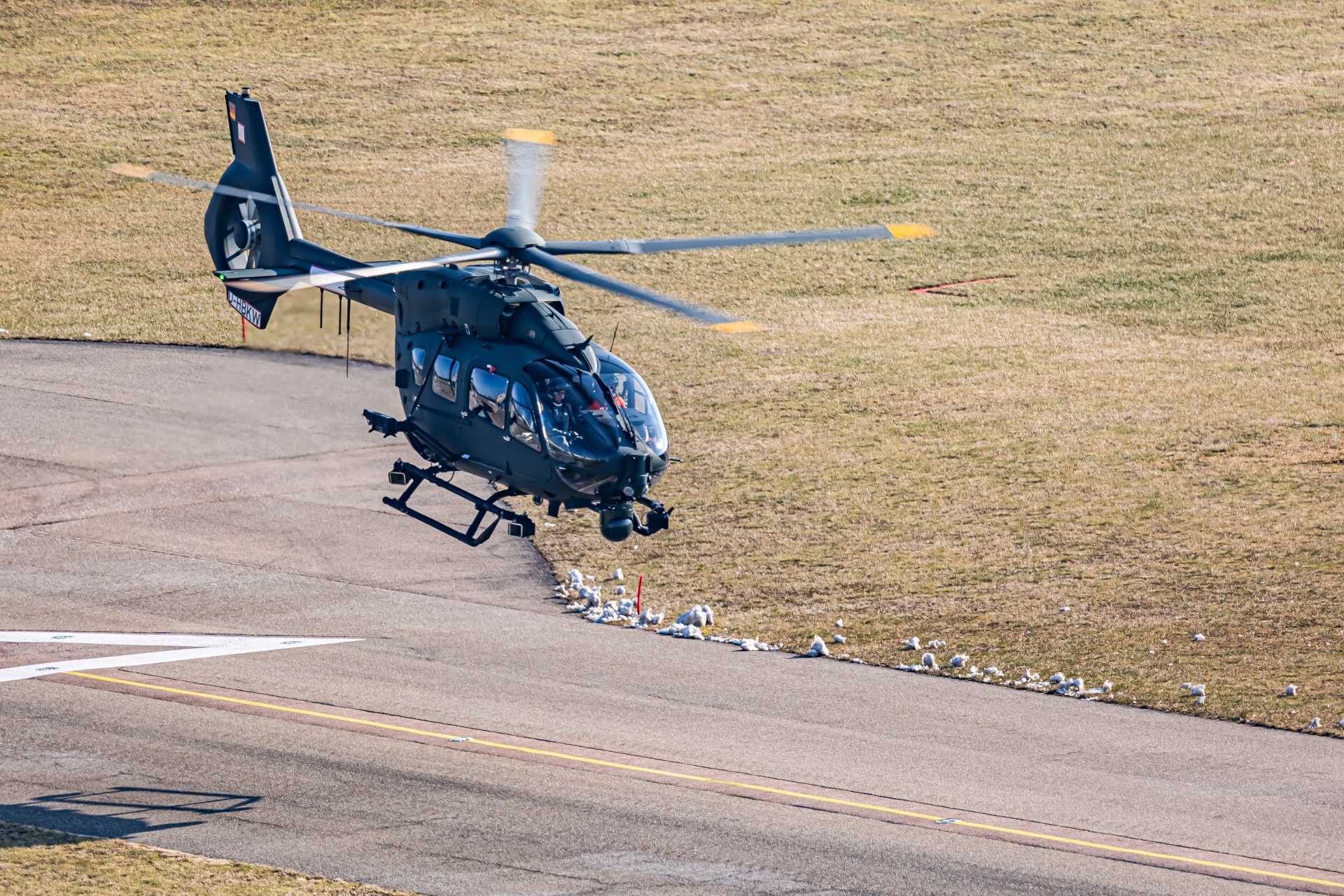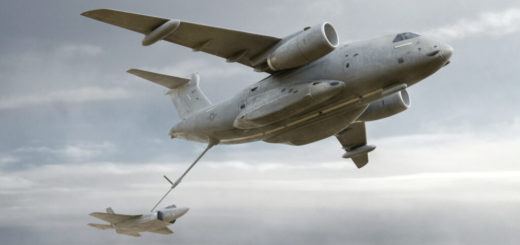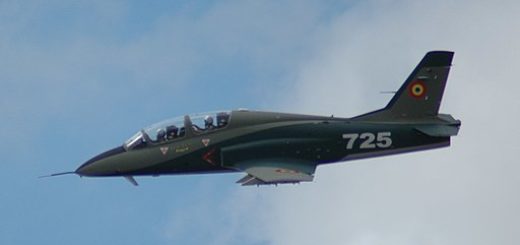Cyprus deploys first H145M multi-role helicopters to replace Russian-made Mi-35Ps

{loadposition bannertop}
{loadposition sidebarpub}
On March 26, 2025, Airbus announced that Cyprus has received the first two of six H145M multi-role helicopters under a contract signed with Airbus Helicopters in June 2022. The delivery was confirmed during a handover ceremony held at the National Guard Air Force Command at the Andreas Papandreou Air Base in Paphos. The remaining four helicopters are scheduled to be delivered by the end of 2025. The new aircraft will replace the 11 Russian-made Mi-35P helicopters previously operated by the Cypriot National Guard and transferred to Serbia in November 2023.Follow Army Recognition on Google News at this link
The H145M variant incorporates a modular weapon system, mission-specific configurations, improved survivability systems, and an increased useful load (Picture source: Airbus)
The contract includes an initial batch of six helicopters and an option for six additional units. While the option remains unconfirmed, the possible acquisition of the second batch would restore the National Guard’s helicopter fleet to a comparable size to that maintained with the Mi-35Ps, reduced to 11 after the loss of one aircraft in 2006. The €53 million contract approved by the Cypriot Parliamentary Defense Committee includes technical support and spare parts. Open sources indicate that the full value of the agreement, including ammunition, may total €140 million, with payments extending until 2026.
The H145M helicopters acquired by Cyprus are equipped with the Airbus’ HForce modular weapon system, allowing configuration for light attack roles. The weapon system includes support for axial ballistic and guided weapons, and each aircraft is equipped with a self-defence system. Images released on social media from the handover ceremony show helicopters armed with 0.50 inch (12.7 mm) FN M3P machine gun pods. Additional compatible armament includes SPIKE ER2 anti-tank missiles, FZ231 unguided rockets, FZ275 laser-guided rockets, and FZ606 guided rockets. The aircraft are configured with multi-purpose pylons capable of carrying gun pods or 20 mm cannons.
According to statements made by the Ministry of Defence spokesperson Christos Pieri, the helicopters have been equipped in accordance with operational requirements defined by the National Guard. Cyprus joins other operators of the H145M, including Germany, the United States, Hungary, Luxembourg, Thailand, Ecuador, Honduras, Serbia, and Brunei. Airbus stated that the helicopters will be used in training, special operations, troop transport, and light attack roles. Three of the Cypriot aircraft have been observed during test flights in Germany. The airframes identified include D-HBKE (c/n 21171, seen January 2023), D-HBKW (c/n 21249, seen March 2024), and D-HBKZ (c/n undetermined, seen March 2024), with corresponding serials Cyprus NG 19-.., 19-55, and 19-56.
The Mi-35P, which the H145M will replace, is a multi-role attack helicopter developed by the Russian Mil Design Bureau in Russia. It represents an upgraded variant of the Mi-24P platform, integrating modern avionics, targeting systems, and guided weapon capabilities. The Mi-35P retains the retractable landing gear and long wings of earlier Mi-24 models, allowing higher speeds—up to 335 km/h—and improved aerodynamics. It is powered by two Klimov TV3-117VMA turboshaft engines generating 2,225 hp each, with a maximum takeoff weight of 11,500 kg and a range of up to 1,000 km. The helicopter features a new OPS-24N-1L sighting system with a third-generation thermal imager, a digital KNEI-24E-1 flight control system with multifunctional displays, and the PrVK-24-2 fire control system.
The Mi-35P’s armament includes a 23mm cannon, up to 2,400 kg of weapons on six pylons, including anti-tank missiles, MANPADS, rocket pods of various calibers, gun pods, grenade launchers, and the capacity to carry bombs or mines. (Picture source: Cyprus National Guard)
The Mi-35P’s armament includes a 23mm GSh-23L cannon on an NPPU-23 mount, up to 2,400 kg of weapons on six pylons, including 9M120-1 Ataka-VM or 9M127-1 Vikhr-1 anti-tank missiles, Igla man-portable air-defense systems (MANPADS) via Strelets modules, rocket pods of various calibers, gun pods, grenade launchers, and the capacity to carry bombs or mines. The Mi-35P can also transport eight troops or four stretchered casualties and is designed to perform in high-temperature and high-altitude environments with reduced maintenance requirements and improved survivability features.
The H145M, derived from the civil H145, is the military version of the BK117 D3. It is powered by two Safran Arriel 2E turboshaft engines delivering 894 shp each, and features Full Authority Digital Engine Control (FADEC). The helicopter includes Airbus’s Helionix digital avionics suite with a four-axis autopilot designed to reduce crew workload and improve flight safety. It can be operated by one or two pilots, supports manned-unmanned teaming (MUM-T), and features the wireless Airborne Communication Server (wACS) for secure data exchange. The H145M has a maximum takeoff weight of 3,800 kg, a useful payload of 1,905 kg, and a sling load capacity of 1,600 kg. It can accommodate up to 10 troops, or be configured for casualty evacuation with two stretcher patients and three medics. The operational ceiling is 6,096 meters (20,000 feet), with a fast cruise speed of 241 km/h, a maximum range of 637 km, and a maximum endurance of 3 hours 30 minutes.
This helicopter incorporates a bearingless and hingeless five-blade main rotor and a Fenestron shrouded tail rotor, contributing to reduced maintenance requirements, compact dimensions for shipborne deployment, and low acoustic signature. Airbus has stated that the H145M can be reconfigured for various roles in a short time, including transport, special operations, ISR (intelligence, surveillance, reconnaissance), and maritime security. Features relevant for naval missions include a four-axis autopilot, emergency floats, weather and search radar, life raft, and emergency locator transmitter (ELT).
The H145 family traces its origins to the Eurocopter EC145, which itself was based on the MBB/Kawasaki BK117. The first EC145 flew in 1999, and production continues under Airbus Helicopters. The military H145M variant was developed with input from operational users and incorporates upgrades, including a modular weapon system, mission-specific configurations, improved survivability systems, and increased useful load by 150 kg over the previous four-bladed version.
The H145 family has accumulated over eight million flight hours globally and is in service with military, law enforcement, and civilian operators in multiple countries. Notable users of the H145M include the German Bundeswehr, U.S. Army (operating nearly 500 UH-72 Lakota helicopters), Serbia, Hungary, and Ecuador. Recent orders include 82 helicopters for Germany, 17 for Belgium, six for Brunei, and four for Ireland. The platform is also operated by various emergency services and state agencies worldwide.
The delivered helicopters were first sighted at Ingolstadt-Manching, Germany, on March 21, 2024, prior to their official transfer. The airframes identified reportedly include D-HBKE (c/n 21171, first seen in January 2023), D-HBKW (c/n 21249, seen March 2024), and D-HBKZ (c/n undetermined, seen March 2024), with corresponding serials Cyprus NG 19-.., 19-55, and 19-56. (Picture source: Twitter/Marios Karatzias)

{loadposition bannertop}
{loadposition sidebarpub}
On March 26, 2025, Airbus announced that Cyprus has received the first two of six H145M multi-role helicopters under a contract signed with Airbus Helicopters in June 2022. The delivery was confirmed during a handover ceremony held at the National Guard Air Force Command at the Andreas Papandreou Air Base in Paphos. The remaining four helicopters are scheduled to be delivered by the end of 2025. The new aircraft will replace the 11 Russian-made Mi-35P helicopters previously operated by the Cypriot National Guard and transferred to Serbia in November 2023.
Follow Army Recognition on Google News at this link
The H145M variant incorporates a modular weapon system, mission-specific configurations, improved survivability systems, and an increased useful load (Picture source: Airbus)
The contract includes an initial batch of six helicopters and an option for six additional units. While the option remains unconfirmed, the possible acquisition of the second batch would restore the National Guard’s helicopter fleet to a comparable size to that maintained with the Mi-35Ps, reduced to 11 after the loss of one aircraft in 2006. The €53 million contract approved by the Cypriot Parliamentary Defense Committee includes technical support and spare parts. Open sources indicate that the full value of the agreement, including ammunition, may total €140 million, with payments extending until 2026.
The H145M helicopters acquired by Cyprus are equipped with the Airbus’ HForce modular weapon system, allowing configuration for light attack roles. The weapon system includes support for axial ballistic and guided weapons, and each aircraft is equipped with a self-defence system. Images released on social media from the handover ceremony show helicopters armed with 0.50 inch (12.7 mm) FN M3P machine gun pods. Additional compatible armament includes SPIKE ER2 anti-tank missiles, FZ231 unguided rockets, FZ275 laser-guided rockets, and FZ606 guided rockets. The aircraft are configured with multi-purpose pylons capable of carrying gun pods or 20 mm cannons.
According to statements made by the Ministry of Defence spokesperson Christos Pieri, the helicopters have been equipped in accordance with operational requirements defined by the National Guard. Cyprus joins other operators of the H145M, including Germany, the United States, Hungary, Luxembourg, Thailand, Ecuador, Honduras, Serbia, and Brunei. Airbus stated that the helicopters will be used in training, special operations, troop transport, and light attack roles. Three of the Cypriot aircraft have been observed during test flights in Germany. The airframes identified include D-HBKE (c/n 21171, seen January 2023), D-HBKW (c/n 21249, seen March 2024), and D-HBKZ (c/n undetermined, seen March 2024), with corresponding serials Cyprus NG 19-.., 19-55, and 19-56.
The Mi-35P, which the H145M will replace, is a multi-role attack helicopter developed by the Russian Mil Design Bureau in Russia. It represents an upgraded variant of the Mi-24P platform, integrating modern avionics, targeting systems, and guided weapon capabilities. The Mi-35P retains the retractable landing gear and long wings of earlier Mi-24 models, allowing higher speeds—up to 335 km/h—and improved aerodynamics. It is powered by two Klimov TV3-117VMA turboshaft engines generating 2,225 hp each, with a maximum takeoff weight of 11,500 kg and a range of up to 1,000 km. The helicopter features a new OPS-24N-1L sighting system with a third-generation thermal imager, a digital KNEI-24E-1 flight control system with multifunctional displays, and the PrVK-24-2 fire control system.

The Mi-35P’s armament includes a 23mm cannon, up to 2,400 kg of weapons on six pylons, including anti-tank missiles, MANPADS, rocket pods of various calibers, gun pods, grenade launchers, and the capacity to carry bombs or mines. (Picture source: Cyprus National Guard)
The Mi-35P’s armament includes a 23mm GSh-23L cannon on an NPPU-23 mount, up to 2,400 kg of weapons on six pylons, including 9M120-1 Ataka-VM or 9M127-1 Vikhr-1 anti-tank missiles, Igla man-portable air-defense systems (MANPADS) via Strelets modules, rocket pods of various calibers, gun pods, grenade launchers, and the capacity to carry bombs or mines. The Mi-35P can also transport eight troops or four stretchered casualties and is designed to perform in high-temperature and high-altitude environments with reduced maintenance requirements and improved survivability features.
The H145M, derived from the civil H145, is the military version of the BK117 D3. It is powered by two Safran Arriel 2E turboshaft engines delivering 894 shp each, and features Full Authority Digital Engine Control (FADEC). The helicopter includes Airbus’s Helionix digital avionics suite with a four-axis autopilot designed to reduce crew workload and improve flight safety. It can be operated by one or two pilots, supports manned-unmanned teaming (MUM-T), and features the wireless Airborne Communication Server (wACS) for secure data exchange. The H145M has a maximum takeoff weight of 3,800 kg, a useful payload of 1,905 kg, and a sling load capacity of 1,600 kg. It can accommodate up to 10 troops, or be configured for casualty evacuation with two stretcher patients and three medics. The operational ceiling is 6,096 meters (20,000 feet), with a fast cruise speed of 241 km/h, a maximum range of 637 km, and a maximum endurance of 3 hours 30 minutes.
This helicopter incorporates a bearingless and hingeless five-blade main rotor and a Fenestron shrouded tail rotor, contributing to reduced maintenance requirements, compact dimensions for shipborne deployment, and low acoustic signature. Airbus has stated that the H145M can be reconfigured for various roles in a short time, including transport, special operations, ISR (intelligence, surveillance, reconnaissance), and maritime security. Features relevant for naval missions include a four-axis autopilot, emergency floats, weather and search radar, life raft, and emergency locator transmitter (ELT).
The H145 family traces its origins to the Eurocopter EC145, which itself was based on the MBB/Kawasaki BK117. The first EC145 flew in 1999, and production continues under Airbus Helicopters. The military H145M variant was developed with input from operational users and incorporates upgrades, including a modular weapon system, mission-specific configurations, improved survivability systems, and increased useful load by 150 kg over the previous four-bladed version.
The H145 family has accumulated over eight million flight hours globally and is in service with military, law enforcement, and civilian operators in multiple countries. Notable users of the H145M include the German Bundeswehr, U.S. Army (operating nearly 500 UH-72 Lakota helicopters), Serbia, Hungary, and Ecuador. Recent orders include 82 helicopters for Germany, 17 for Belgium, six for Brunei, and four for Ireland. The platform is also operated by various emergency services and state agencies worldwide.

The delivered helicopters were first sighted at Ingolstadt-Manching, Germany, on March 21, 2024, prior to their official transfer. The airframes identified reportedly include D-HBKE (c/n 21171, first seen in January 2023), D-HBKW (c/n 21249, seen March 2024), and D-HBKZ (c/n undetermined, seen March 2024), with corresponding serials Cyprus NG 19-.., 19-55, and 19-56. (Picture source: Twitter/Marios Karatzias)







